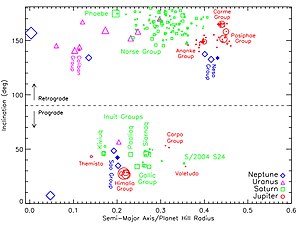
Back قمر غير نظامي Arabic Нерэгулярны спадарожнік Byelorussian Нерегулярен спътник Bulgarian Satèl·lit irregular Catalan Irregulärer Satellit German Neregula satelito Esperanto Satélite irregular Spanish قمر نامنظم Persian Satellite irrégulier French Անկանոն արբանյակ Armenian

In astronomy, an irregular moon, irregular satellite, or irregular natural satellite is a natural satellite following a distant, inclined, and often highly elliptical and retrograde orbit. They have been captured by their parent planet, unlike regular satellites, which formed in orbit around them. Irregular moons have a stable orbit, unlike temporary satellites which often have similarly irregular orbits but will eventually depart. The term does not refer to shape; Triton, for example, is a round moon but is considered irregular due to its orbit and origins.
As of February 2024[update], 228 irregular moons are known, orbiting all four of the outer planets (Jupiter, Saturn, Uranus, and Neptune). The largest of each planet are Himalia of Jupiter, Phoebe of Saturn, Sycorax of Uranus, and Triton of Neptune. Triton is rather unusual for an irregular moon; if it is excluded, then Nereid is the largest irregular moon around Neptune. It is currently thought that the irregular satellites were once independent objects orbiting the Sun before being captured by a nearby planet, early in the history of the Solar System. An alternative theory, that they originated further out in the Kuiper belt, is not supported by current observations.[citation needed]
© MMXXIII Rich X Search. We shall prevail. All rights reserved. Rich X Search